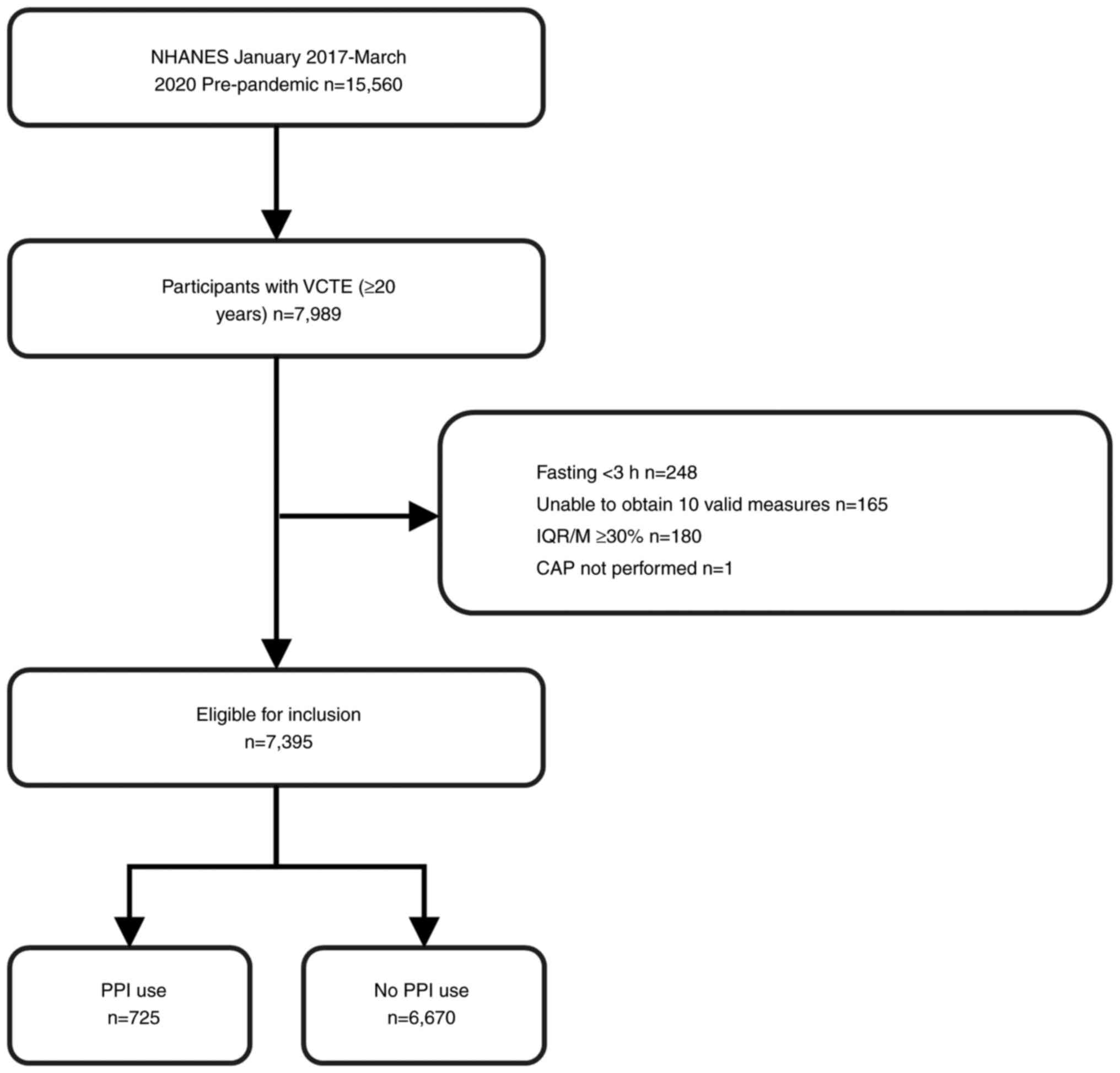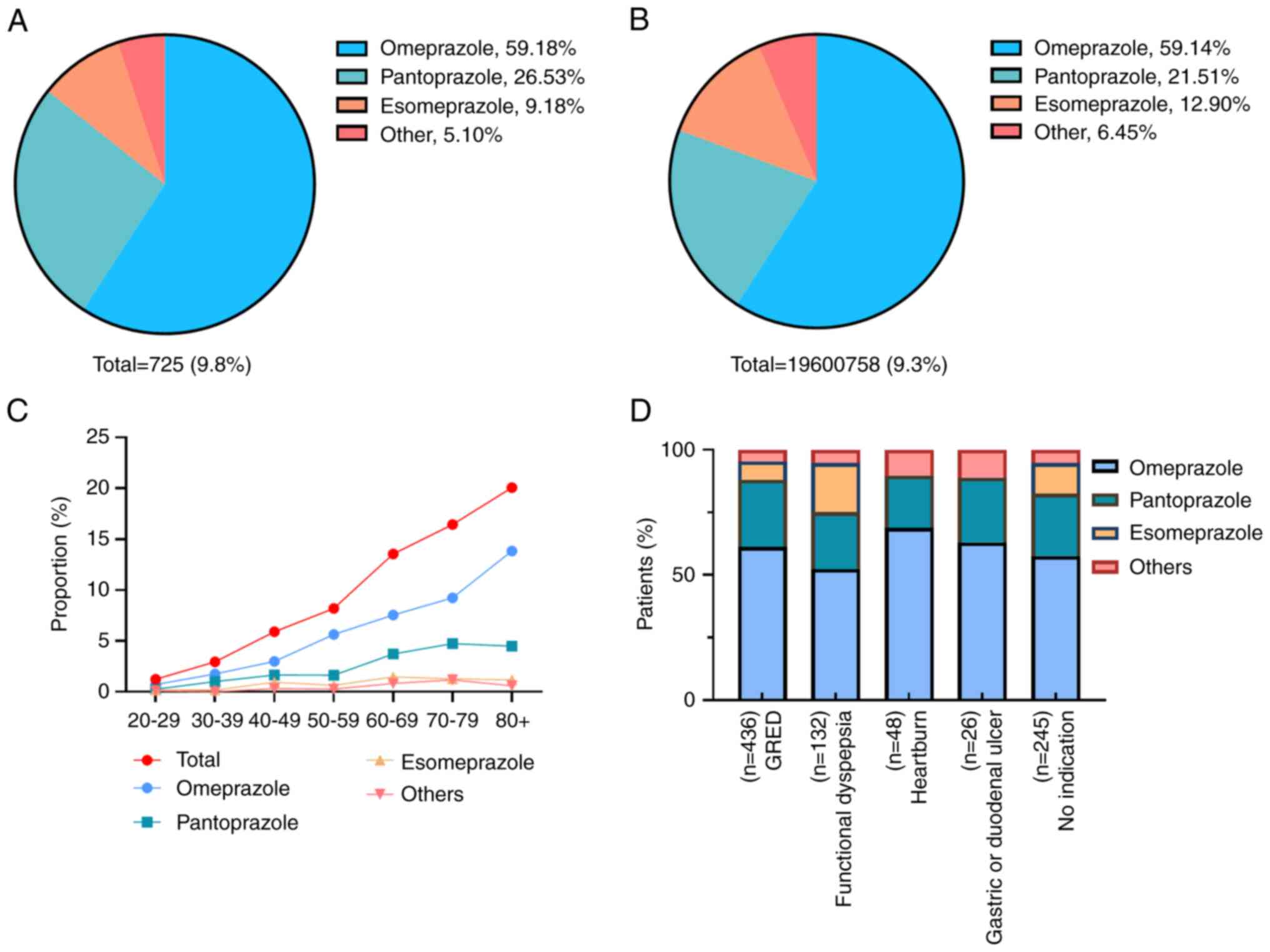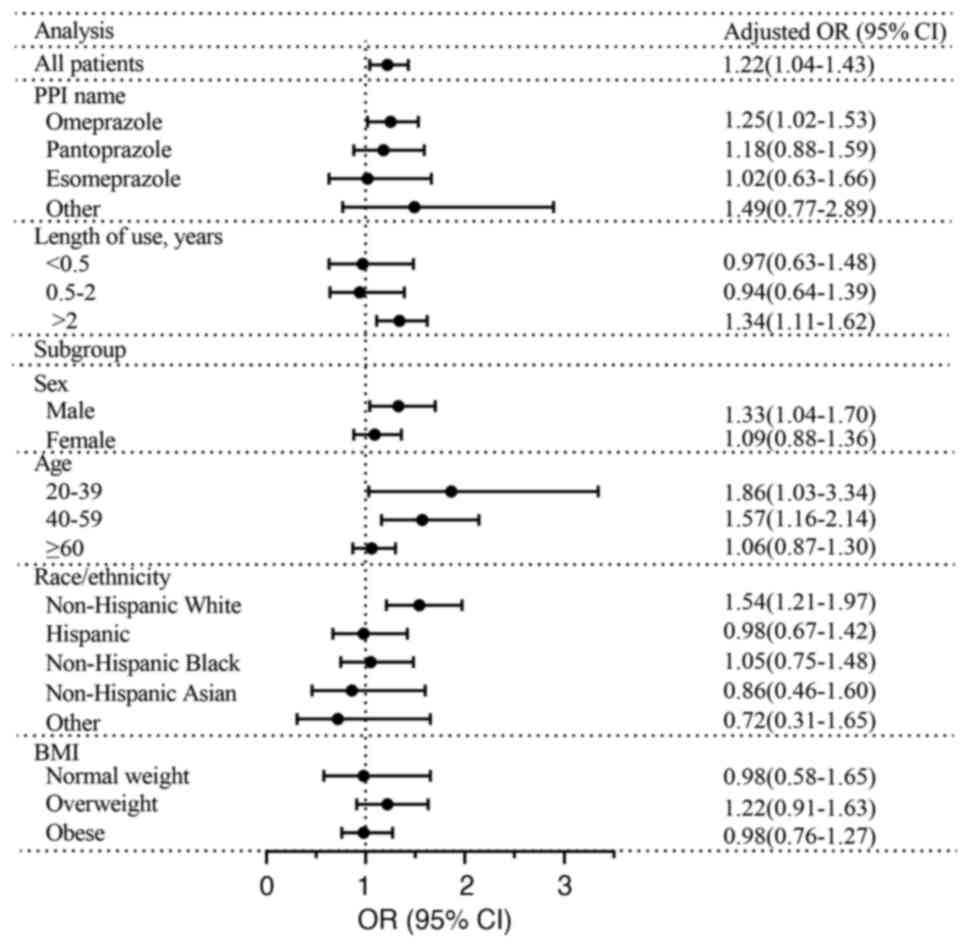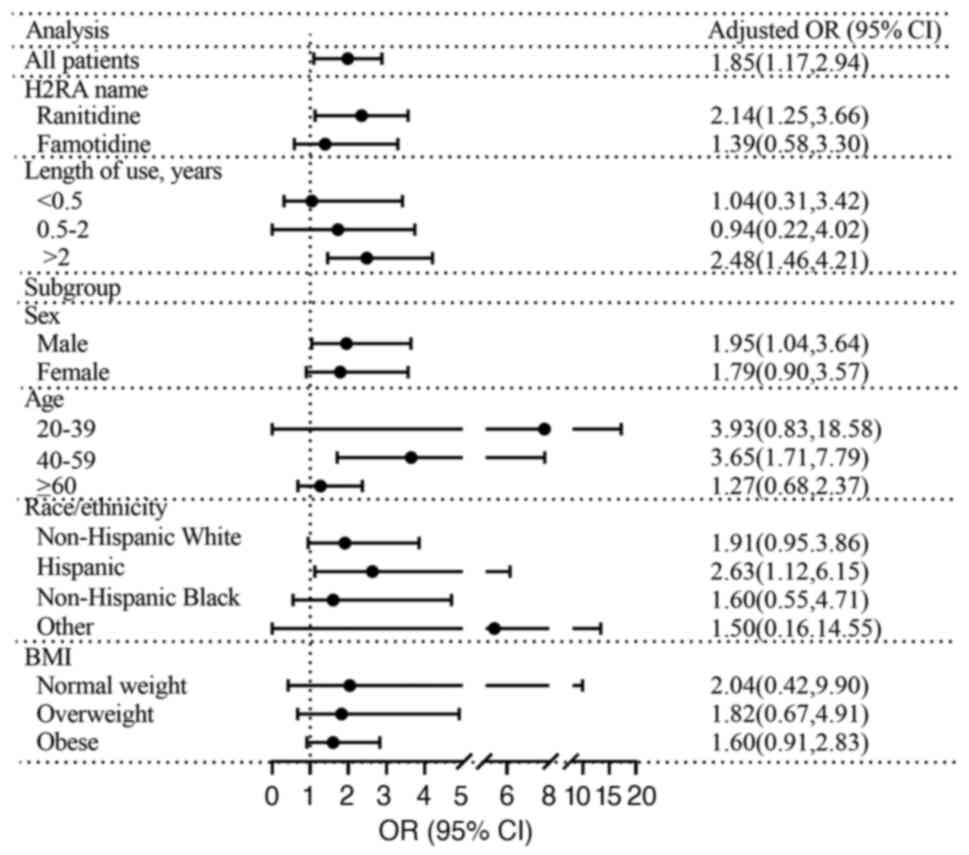|
1
|
Kantor ED, Rehm CD, Haas JS, Chan AT and
Giovannucci EL: Trends in prescription drug use among adults in the
United States from 1999-2012. JAMA. 314:1818–1831. 2015.PubMed/NCBI View Article : Google Scholar
|
|
2
|
Targownik LE, Fisher DA and Saini SD: AGA
clinical practice update on de-prescribing of proton pump
inhibitors: Expert review. Gastroenterology. 162:1334–1342.
2022.PubMed/NCBI View Article : Google Scholar
|
|
3
|
Ahrens D, Chenot JF, Behrens G, Grimmsmann
T and Kochen MM: Appropriateness of treatment recommendations for
PPI in hospital discharge letters. Eur J Clin Pharmacol.
66:1265–1271. 2010.PubMed/NCBI View Article : Google Scholar
|
|
4
|
Al-Aly Z, Maddukuri G and Xie Y: Proton
pump inhibitors and the Kidney: Implications of current evidence
for clinical practice and when and how to deprescribe. Am J Kidney
Dis. 75:497–507. 2020.PubMed/NCBI View Article : Google Scholar
|
|
5
|
Northuis CA, Bell EJ, Lutsey PL, George
KM, Gottesman RF, Mosley TH, Whitsel EA and Lakshminarayan K:
Cumulative use of proton pump inhibitors and risk of dementia: The
atherosclerosis risk in communities study. Neurology.
101:e1771–e1778. 2023.PubMed/NCBI View Article : Google Scholar
|
|
6
|
Yang YX, Lewis JD, Epstein S and Metz DC:
Long-term proton pump inhibitor therapy and risk of hip fracture.
JAMA. 296:2947–2953. 2006.PubMed/NCBI View Article : Google Scholar
|
|
7
|
Tseng HJ, Cheng CM, Tsai SJ, Lin WC, Bai
YM, Tsai CF, Su TP, Li CT, Chen TJ and Chen MH: Proton pump
inhibitor exposure and acute myocardial infarction risk: A nested
cohort study. Cardiovasc Toxicol. 21:444–450. 2021.PubMed/NCBI View Article : Google Scholar
|
|
8
|
Lo WK and Chan WW: Proton pump inhibitor
use and the risk of small intestinal bacterial overgrowth: A
meta-analysis. Clin Gastroenterol Hepatol. 11:483–490.
2013.PubMed/NCBI View Article : Google Scholar
|
|
9
|
Choudhury A, Jena A, Jearth V, Dutta AK,
Makharia G, Dutta U, Goenka M, Kochhar R and Sharma V: Vitamin B12
deficiency and use of proton pump inhibitors: A systematic review
and meta-analysis. Expert Rev Gastroenterol Hepatol. 17:479–487.
2023.PubMed/NCBI View Article : Google Scholar
|
|
10
|
Joo MK, Park JJ and Chun HJ: Proton pump
inhibitor: The dual role in gastric cancer. World J Gastroenterol.
25:2058–2070. 2019.PubMed/NCBI View Article : Google Scholar
|
|
11
|
Li DK, Yan P, Abou-Samra AB, Chung RT and
Butt AA: Proton pump inhibitors are associated with accelerated
development of cirrhosis, hepatic decompensation and hepatocellular
carcinoma in noncirrhotic patients with chronic hepatitis C
infection: Results from ERCHIVES. Aliment Pharmacol Ther.
47:246–258. 2018.PubMed/NCBI View Article : Google Scholar
|
|
12
|
Mahmud N, Serper M, Taddei TH and Kaplan
DE: The association between proton pump inhibitor exposure and key
liver-related outcomes in patients with cirrhosis: A veterans
affairs cohort study. Gastroenterology. 163:257–269.e6.
2022.PubMed/NCBI View Article : Google Scholar
|
|
13
|
De Roza MA, Kai L, Kam JW, Chan YH, Kwek
A, Ang TL and Hsiang JC: Proton pump inhibitor use increases
mortality and hepatic decompensation in liver cirrhosis. World J
Gastroenterol. 25:4933–4944. 2019.PubMed/NCBI View Article : Google Scholar
|
|
14
|
Eusebi LH, Rabitti S, Artesiani ML, Gelli
D, Montagnani M, Zagari RM and Bazzoli F: Proton pump inhibitors:
Risks of long-term use. J Gastroenterol Hepatol. 32:1295–1302.
2017.PubMed/NCBI View Article : Google Scholar
|
|
15
|
Freedberg DE, Kim LS and Yang YX: The
risks and benefits of long-term use of proton pump inhibitors:
Expert review and best practice advice from the American
gastroenterological association. Gastroenterology. 152:706–715.
2017.PubMed/NCBI View Article : Google Scholar
|
|
16
|
Vilar-Gomez E, Vuppalanchi R, Gawrieh S,
Samala N and Chalasani N: CAP and LSM as determined by VCTE are
independent predictors of all-cause mortality in the US adult
population. Hepatology. 77:1241–1252. 2023.PubMed/NCBI View Article : Google Scholar
|
|
17
|
Rinella ME, Neuschwander-Tetri BA,
Siddiqui MS, Abdelmalek MF, Caldwell S, Barb D, Kleiner DE and
Loomba R: AASLD practice guidance on the clinical assessment and
management of nonalcoholic fatty liver disease. Hepatology.
77:1797–1835. 2023.PubMed/NCBI View Article : Google Scholar
|
|
18
|
Kim D, Konyn P, Cholankeril G and Ahmed A:
Physical activity is associated with nonalcoholic fatty liver
disease and significant fibrosis measured by FibroScan. Clin
Gastroenterol Hepatol. 20:e1438–e1455. 2022.PubMed/NCBI View Article : Google Scholar
|
|
19
|
Eddowes PJ, Sasso M, Allison M, Tsochatzis
E, Anstee QM, Sheridan D, Guha IN, Cobbold JF, Deeks JJ, Paradis V,
et al: Accuracy of fibroscan controlled attenuation parameter and
liver stiffness measurement in assessing steatosis and fibrosis in
patients with nonalcoholic fatty liver disease. Gastroenterology.
156:1717–1730. 2019.PubMed/NCBI View Article : Google Scholar
|
|
20
|
Ciardullo S and Perseghin G: Statin use is
associated with lower prevalence of advanced liver fibrosis in
patients with type 2 diabetes. Metabolism.
121(154752)2021.PubMed/NCBI View Article : Google Scholar
|
|
21
|
Bedossa P and Poynard T: An algorithm for
the grading of activity in chronic hepatitis C. The METAVIR
cooperative study group. Hepatology. 24:289–293. 1996.PubMed/NCBI View Article : Google Scholar
|
|
22
|
Leung CW and Tapper EB: Sugar-sweetened
beverages are associated with increased liver stiffness and
steatosis among apparently healthy adults in the United States.
Clin Gastroenterol Hepatol. 20:959–961.e1. 2022.PubMed/NCBI View Article : Google Scholar
|
|
23
|
Vilar-Gomez E, Nephew LD, Vuppalanchi R,
Gawrieh S, Mladenovic A, Pike F, Samala N and Chalasani N:
High-quality diet, physical activity, and college education are
associated with low risk of NAFLD among the US population.
Hepatology. 75:1491–1506. 2022.PubMed/NCBI View Article : Google Scholar
|
|
24
|
Phan H, Richard A, Lazo M, Nelson WG,
Denmeade SR, Groopman J, Kanarek N, Platz EA and Rohrmann S: The
association of sex steroid hormone concentrations with
non-alcoholic fatty liver disease and liver enzymes in US men.
Liver Int. 41:300–310. 2021.PubMed/NCBI View Article : Google Scholar
|
|
25
|
Yang HH, Chen GC, Zhou MG, Xie LF, Jin YY,
Chen HT, Chen ZK, Kong YH, Yuan CZ and Li ZH: Association of age at
first birth and risk of non-alcoholic fatty liver disease in women:
Evidence from the NHANES. Hepatol Int. 17:303–312. 2023.PubMed/NCBI View Article : Google Scholar
|
|
26
|
Siddiqui MS, Vuppalanchi R, Van Natta ML,
Hallinan E, Kowdley KV, Abdelmalek M, Neuschwander-Tetri BA, Loomba
R, Dasarathy S, Brandman D, et al: Vibration-controlled transient
elastography to assess fibrosis and steatosis in patients with
nonalcoholic fatty liver disease. Clin Gastroenterol Hepatol.
17:156–163.e2. 2019.PubMed/NCBI View Article : Google Scholar
|
|
27
|
Chalasani N, Younossi Z, Lavine JE,
Charlton M, Cusi K, Rinella M, Harrison SA, Brunt EM and Sanyal AJ:
The diagnosis and management of nonalcoholic fatty liver disease:
Practice guidance from the American association for the study of
liver diseases. Hepatology. 67:328–357. 2018.PubMed/NCBI View Article : Google Scholar
|
|
28
|
Rinella ME, Lazarus JV, Ratziu V, Francque
SM, Sanyal AJ, Kanwal F, Romero D, Abdelmalek MF, Anstee QM, Arab
JP, et al: A multisociety Delphi consensus statement on new fatty
liver disease nomenclature. Ann Hepatol. 29(101133)2024.PubMed/NCBI View Article : Google Scholar
|
|
29
|
Younossi ZM, Koenig AB, Abdelatif D, Fazel
Y, Henry L and Wymer M: Global epidemiology of nonalcoholic fatty
liver disease-meta-analytic assessment of prevalence, incidence,
and outcomes. Hepatology. 64:73–84. 2016.PubMed/NCBI View Article : Google Scholar
|
|
30
|
Buzzetti E, Pinzani M and Tsochatzis EA:
The multiple-hit pathogenesis of non-alcoholic fatty liver disease
(NAFLD). Metabolism. 65:1038–1048. 2016.PubMed/NCBI View Article : Google Scholar
|
|
31
|
Magee N, Ahamed F, Eppler N, Jones E,
Ghosh P, He L and Zhang Y: Hepatic transcriptome profiling reveals
early signatures associated with disease transition from
non-alcoholic steatosis to steatohepatitis. Liver Res. 6:238–250.
2022.PubMed/NCBI View Article : Google Scholar
|
|
32
|
Shen H and Liangpunsakul S: Histamine
H2-receptor antagonist use is associated with lower prevalence of
nonalcoholic fatty liver disease: A population-based study from the
national health and nutrition examination survey, 2001-2006. J Clin
Gastroenterol. 50:596–601. 2016.PubMed/NCBI View Article : Google Scholar
|
|
33
|
Pyo JH, Kim TJ, Lee H, Choi SC, Cho SJ,
Choi YH, Min YW, Min BH, Lee JH, Kang M, et al: Proton pump
inhibitors use and the risk of fatty liver disease: A nationwide
cohort study. J Gastroenterol Hepatol. 36:1235–1243.
2021.PubMed/NCBI View Article : Google Scholar
|
|
34
|
Llorente C, Jepsen P, Inamine T, Wang L,
Bluemel S, Wang HJ, Loomba R, Bajaj JS, Schubert ML, Sikaroodi M,
et al: Gastric acid suppression promotes alcoholic liver disease by
inducing overgrowth of intestinal Enterococcus. Nat Commun.
8(837)2017.PubMed/NCBI View Article : Google Scholar
|
|
35
|
Huang H, Liu Z, Guo Y, Zeng Y, Shen S and
Xu C: Long-term use of proton pump inhibitors is associated with an
increased risk of nonalcoholic fatty liver disease. J Clin
Gastroenterol. 58:289–296. 2024.PubMed/NCBI View Article : Google Scholar
|
|
36
|
Corleto VD, Festa S, Di Giulio E and
Annibale B: Proton pump inhibitor therapy and potential long-term
harm. Curr Opin Endocrinol Diabetes Obes. 21:3–8. 2014.PubMed/NCBI View Article : Google Scholar
|
|
37
|
Tsai MC, Liu YY, Lin CC, Wang CC, Wu YJ,
Yong CC, Chen KD, Chuah SK, Yao CC, Huang PY, et al: Gut microbiota
dysbiosis in patients with biopsy-proven nonalcoholic fatty liver
disease: A cross-sectional study in Taiwan. Nutrients.
12(820)2020.PubMed/NCBI View Article : Google Scholar
|
|
38
|
Demir M, Lang S, Hartmann P, Duan Y,
Martin A, Miyamoto Y, Bondareva M, Zhang X, Wang Y, Kasper P, et
al: The fecal mycobiome in non-alcoholic fatty liver disease. J
Hepatol. 76:788–799. 2022.PubMed/NCBI View Article : Google Scholar
|
|
39
|
Schwimmer JB, Johnson JS, Angeles JE,
Behling C, Belt PH, Borecki I, Bross C, Durelle J, Goyal NP,
Hamilton G, et al: Microbiome signatures associated with
steatohepatitis and moderate to severe fibrosis in children with
nonalcoholic fatty liver disease. Gastroenterology. 157:1109–1122.
2019.PubMed/NCBI View Article : Google Scholar
|
|
40
|
Lee G, You HJ, Bajaj JS, Joo SK, Yu J,
Park S, Kang H, Park JH, Kim JH, Lee DH, et al: Distinct signatures
of gut microbiome and metabolites associated with significant
fibrosis in non-obese NAFLD. Nat Commun. 11(4982)2020.PubMed/NCBI View Article : Google Scholar
|
|
41
|
Garcia-Martinez I, Francés R, Zapater P,
Giménez P, Gómez-Hurtado I, Moratalla A, Lozano-Ruiz B, Bellot P,
González-Navajas JM and Such J: Use of proton pump inhibitors
decrease cellular oxidative burst in patients with decompensated
cirrhosis. J Gastroenterol Hepatol. 30:147–154. 2015.PubMed/NCBI View Article : Google Scholar
|
|
42
|
Ciardullo S, Rea F, Savaré L, Morabito G,
Perseghin G and Corrao G: Prolonged use of proton pump inhibitors
and risk of type 2 diabetes: Results from a large population-based
nested case-control study. J Clin Endocrinol Metab.
107:e2671–e2679. 2022.PubMed/NCBI View Article : Google Scholar
|
|
43
|
Czarniak P, Ahmadizar F, Hughes J, Parsons
R, Kavousi M, Ikram M and Stricker BH: Proton pump inhibitors are
associated with incident type 2 diabetes mellitus in a prospective
population-based cohort study. Br J Clin Pharmacol. 88:2718–2726.
2022.PubMed/NCBI View Article : Google Scholar
|
|
44
|
Czwornog JL and Austin GL: Association of
proton pump inhibitor (PPI) use with energy intake, physical
activity, and weight gain. Nutrients. 7:8592–8601. 2015.PubMed/NCBI View Article : Google Scholar
|
|
45
|
Helgadóttir H, Metz DC, Lund SH,
Gizurarson S, Jacobsen EI, Asgeirsdóttir GA, Yngadóttir Y and
Björnsson ES: Study of gender differences in proton pump inhibitor
dose requirements for GERD: A double-blind randomized trial. J Clin
Gastroenterol. 51:486–493. 2017.PubMed/NCBI View Article : Google Scholar
|
|
46
|
Nguyen TH, Thrift AP, Ramsey D, Green L,
Shaib YH, Graham DY and El-Serag HB: Risk factors for Barrett's
esophagus compared between African Americans and non-Hispanic
Whites. Am J Gastroenterol. 109:1870–1880. 2014.PubMed/NCBI View Article : Google Scholar
|













